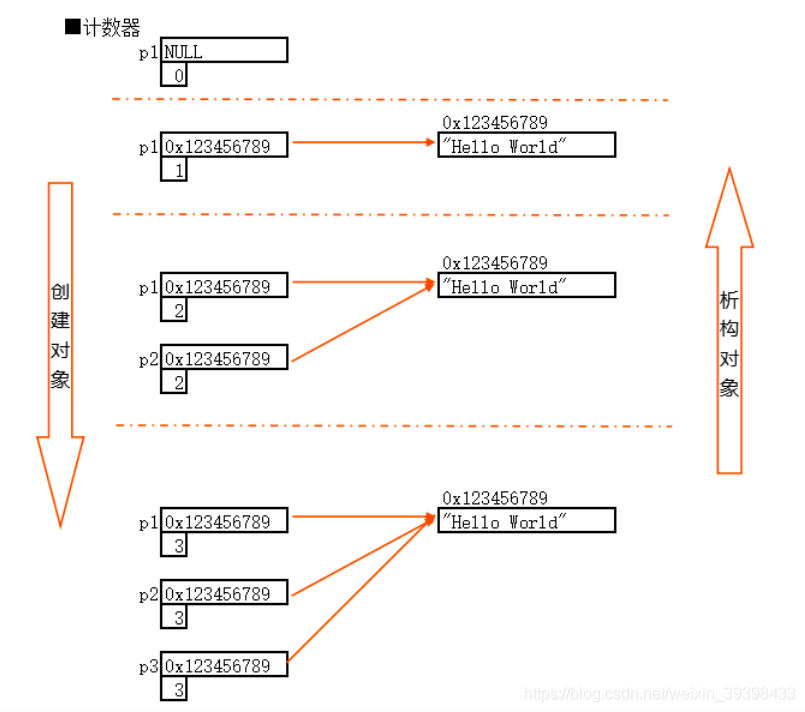文章目录
智能指针
指针的危害
- 指针未初始化
- 野指针
- 内存泄漏
1. 智能指针 auto_ptr
1.1 auto_ptr的原理
作用:
对作用域内的动态分配对象的自动释放
#include<iostream>
#include <memory>
using namespace std;
class Test{
public:
Test(){cout << __func__ << endl;}
~Test(){cout << __func__ << endl;}
void Func(int n)const{
cout << n << endl;
}
};
int main(){
// Test* p = new Test;
auto_ptr<Test> p(new Test);
p->Func(100);
// delete pp;
}
编译时显示改用法已经废弃,但执行结果为:
Test
100
~Test
我们自己定义一个智能指针的模板,看看该智能指针做了什么操作
#include<iostream>
#include <memory>
using namespace std;
class Test{
public:
Test(){cout << __func__ << endl;}
~Test(){cout << __func__ << endl;}
void Func(int n)const{
cout << n << endl;
}
};
// 自己定义一个智能指针
namespace MySTL{
template<typename T>
class auto_ptr{
T* p;
public:
auto_ptr(T* p):p(p){} // 构造
~auto_ptr(){ // 析构
delete p;
}
T* operator ->(){ // ->运算符重载
return p;
}
T& operator *(){ // *运算符重载
return *p;
}
};
};
int main(){
MySTL::auto_ptr<Test> p(new Test);
p->Func(100);
// 如同 p.operator->()->Func(100);
(*p).Func(100);
}
结果为:
Test
100
100
~Test
1.2 内存检测工具的使用
安装内存检测工具:
yum -y install valgrind
对于上述例子,如果我们忘记释放指针,即主函数改为:
int main(){
Test* pp = new Test;
MySTL::auto_ptr<Test> p(new Test);
p->Func(100);
(*p).Func(100);
// delete pp;
}
那我们就可以看到,有一个内存泄漏
[root@foundation1 C++7.4]# g++ -g smart.cpp
[root@foundation1 C++7.4]# valgrind ./a.out 使用内存检测工具
// ...... 此处省略
==10758== LEAK SUMMARY:
==10758== definitely lost: 1 bytes in 1 blocks // 有一处内存泄漏
==10758== indirectly lost: 0 bytes in 0 blocks
// ...... 此处省略
[root@foundation1 C++7.4]# valgrind --leak-check=full -v ./a.out // 查看详细信息
// ...... 此处省略
==10828== 1 bytes in 1 blocks are definitely lost in loss record 1 of 1
==10828== at 0x4C31556: operator new(unsigned long) (vg_replace_malloc.c:344)
==10828== by 0x400A3A: main (smart.cpp:35) // 表示35行处申请的内存发生泄漏
==10828==
==10828== LEAK SUMMARY:
==10828== definitely lost: 1 bytes in 1 blocks
// ...... 此处省略
1.3 数组指针的释放
数组内存的申请和释放需要注意写法,我们把主函数改为:
int main(){
Test* pp = new Test;
MySTL::auto_ptr<Test> p(new Test);
p->Func(100);
(*p).Func(100);
delete pp;
int* arr = new int[10];
delete [] arr;
// delete arr; 这是不对的,只能释放一个指针
}
结果为:
[root@foundation1 C++7.4]# g++ -g smart.cpp
[root@foundation1 C++7.4]# valgrind --leak-check=full -v ./a.out
// ...... 此处省略
==11117== All heap blocks were freed -- no leaks are possible
==11117==
==11117== ERROR SUMMARY: 0 errors from 0 contexts (suppressed: 0 from 0) // 没有内存错误
1.4 赋值操作的问题
当赋值的时候,使用智能指针 auto_ptr 就会出现二次释放的问题
把主函数改为:
int main(){
MySTL::auto_ptr<Test> p(new Test);
p->Func(100);
(*p).Func(100);
MySTL::auto_ptr<Test> p2 = p; // 赋值操作,会出现问题
p2->Func(200);
p->Func(300);
}
显示结果为内存二次释放:
Test
100
100
200
300
~Test
~Test
free(): double free detected in tcache 2
Aborted (core dumped)
所以我们尽量不用智能指针 auto_ptr
2. 智能指针 unique_ptr
作用和 auto_ptr 一样,特点是,不能赋值和赋值
如果我们向上面方式写 unique_ptr
int main(){
unique_ptr<Test> p(new Test);
p->Func(100);
(*p).Func(100);
unique_ptr<Test> p2 = p; // 赋值操作,会直接报错
p2->Func(200);
p->Func(300);
}
编译时就会报错
3. 智能指针 scoped_ptr
作用与unique_ptr相似,在本作用域中使用,不能复制与赋值。
4. 智能指针 shared_ptr
如果非要赋值,我们可以使用智能指针 shared_ptr ,不会出现二次释放
把上例主函数改为:
int main(){
shared_ptr<Test> p(new Test);
p->Func(100);
(*p).Func(100);
shared_ptr<Test> p2 = p; // 赋值操作,会直接报错
p2->Func(200);
p->Func(300);
}
就不会报错,能正常运行
4.1 shared_ptr的原理
其实是对每一个指针计数,每拷贝一份计数加一,每析构一次计数减一,这就可以避免多次释放
我们自己定义一个智能指针的模板,看看该智能指针做了什么操作
#include<iostream>
#include <memory>
using namespace std;
class Test{
public:
Test(){cout << __func__ << endl;}
~Test(){cout << __func__ << endl;}
void Func(int n)const{
cout << n << endl;
}
};
namespace MySTL{
// 看看shared_ptr是怎么做的
template<typename T>
class shared_ptr{
struct Record{
T* p;
int count; // 用来计数的
};
Record* record;
public:
// 构造函数
shared_ptr(T* p){
record = new Record{p,1};
}
// 拷贝构造函数
shared_ptr(const shared_ptr& ptr){
record = ptr.record;
++record->count; // 地址个数增加
}
// 赋值运算符重载
shared_ptr& operator = (const shared_ptr& ptr){
if(this == &ptr) return *this; // 自己给自己赋值
if(record->p == ptr.record->p) return *this;
--record->count;
if(0 == record->count){
delete record->p;
delete record;
}
record = ptr.record;
++record->count;
return *this;
}
// 析构函数
~shared_ptr(){
--record->count; // 访问地址个数减一
if(0 == record->count) {
delete record->p; // 要对指针释放
delete record;
}
}
T* operator ->(){
return record->p;
}
T& operator *(){
return *(record->p);
}
};
};
int main(){
// Test* pp = new Test;
MySTL::shared_ptr<Test> p(new Test);
p->Func(100);
// delete pp;
MySTL::shared_ptr<Test> p2 = p; // 调用拷贝构造
p2->Func(200);
p->Func(300);
MySTL::shared_ptr<Test> p3(new Test);
p3 = p; // 调用赋值运算符重载
p3->Func(400);
}
结果为:
Test
100
200
300
Test
~Test
400
~Test

4.2 数组指针的释放
数组指针的释放的另一种方法
我们把主函数改为:
加上中括号表示这是数组,需要多次释放
#include<iostream>
#include <memory>
using namespace std;
class Test{
public:
Test(){cout << __func__ << endl;}
~Test(){cout << __func__ << endl;}
void Func(int n)const{
cout << n << endl;
}
};
int main(){
// unique_ptr<Test> p(new Test[5]);
unique_ptr<Test[]> p(new Test[5]);
}
结果为:
Test
Test
Test
Test
Test
~Test
~Test
~Test
~Test
~Test
不仅是unique_ptr , shared_ptr 也可以这样用,十分方便
5. 智能指针 weak_ptr
对于循环引用问题
当两个类之间相互定义时,使用 shared_ptr 会有一些问题,在赋值时 a->pb = b; 会不知道析构谁,我们需要使用箬指针 weak_ptr
#include <iostream>
#include <memory>
using namespace std;
class A;
class B;
class A{
public:
weak_ptr<B> pb;
A(){cout << __func__ << endl;}
~A(){cout << __func__ << endl;}
};
class B{
public:
weak_ptr<A> pa;
B(){cout << __func__ << endl;}
~B(){cout << __func__ << endl;}
};
int main(){
shared_ptr<A> a(new A);
shared_ptr<B> b(new B); // 各自析构各自的没有问题
a->pb = b; // 出现循环引用,不会析构,除非使用weak
b->pa = a;
}
结果为:
A
B
~B
~A
智能指针weak_ptr主要用来协助shared_ptr
不参与引用计数,但是有以下好处:
- 打破递归的依赖关系
- 使用一个共享的资源但是不要所有权,不添加引用计数
- 避免悬空指针。
写时拷贝技术
用智能指针实现
#include <iostream>
#include <cstring>
#include <memory>
using namespace std;
class String{
shared_ptr<char[]> ptr; // 智能指针
public:
// 构造函数
String(const char* s){
char* t = new char[strlen(s)+1];
strcpy(t,s);
ptr = shared_ptr<char[]>(t);
}
// 析构函数
~String(){
cout << __func__ << endl;
}
// 打印信息
friend ostream& operator << (ostream& os,const String s){
return os << (void*)s.ptr.get() << ":" << s.ptr.get(); // 访问指针地址和内容
}
size_t size()const{
return strlen(ptr.get());
}
String operator+(const String& s)const{
char* t = new char[size()+s.size()+1];
strcpy(t,ptr.get());
strcat(t,s.ptr.get());
return String(t);
}
};
int main(){
String s = "abcd";
cout << s << endl;
String t = s;
t = "def"; // String("def") 隐藏对象
cout << s << endl;
cout << t << endl;
cout << s+t << endl;
}
结果为:
0xf9feb0:abcd
~String
~String
0xf9feb0:abcd
~String
0xfa0300:def
~String
0xfa0360:abcddef
~String
~String
~String